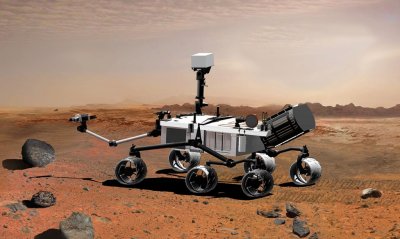Planetarium manager picked to view Mars landing at NASA mission control
Brad Snowder, manager of the Western Washington University Planetarium and lecturer in Western's physics and astronomy department, has been selected by NASA to join a team of 25 social networking mission specialists working to create buzz about the landing of the Mars Science Laboratory Curiosity Rover on Aug. 5.
Snowder will spend three days at the Jet Propulsion Laboratory in Pasadena, Calif., and he'll get to be in mission control during the entry, descent and landing of the rover.
The program, known as NASA Social, became so popular after its June launch that NASA has added five additional sites to the program. At JPL, Snowder's task will be to live tweet and otherwise create a stream of updates on the mission status to Facebook, Twitter, Google Plus, personal blogs and other online networks.
"I'm still in a little bit of shock," says Snowder, who refers to himself as a space geek. Already he has been in communication with the 24 other folks he'll spend time with at JPL. They've been planning dinners and activities and sharing their excitement for the experience.
Snowder will get to sit in mission control during the rover's entry and landing procedure, which he refers to as "seven minutes of terror."
"It's by far the most complicated landing that NASA has even done," Snowder says.
And because of the 14 1/2-minute time delay between Mars and Earth, scientists won't know immediately know whether the landing was successful. But Snowder will get to be present when that first transmission from the landed Curiosity comes through to mission control.
He and the others will get a special mission patch. They'll also tour the facility, meet with scientists and engineers and participate in press conferences. It'll be a whirlwind three days, Snowder says.
He'll be posting the full experience on various social media sites, including his personal Twitter and Google+ accounts and the WWU Planetarium's Facebook page.
The purpose of NASA’s Mars Science Laboratory mission is to study whether the Gale Crater area of Mars has evidence of past and present habitable environments, according to a press release from NASA. These studies will be part of a broader examination of past and present processes in the Martian atmosphere and on its surface. The primary mission will last one Mars year (98 weeks).
Snowder is a Western alumnus with a master's degree in science education, a bachelor's degree in physics and minors in astronomy and math. He holds the Astronomical League's certificates for the Herschel 400 and the Messier deep sky observing programs. He teaches astronomy at Western and at Whatcom Community College. In the past he has taught astronomy courses for Skagit Valley College and for Northwest Indian College. He has managed the WWU Planetarium since 1995.

